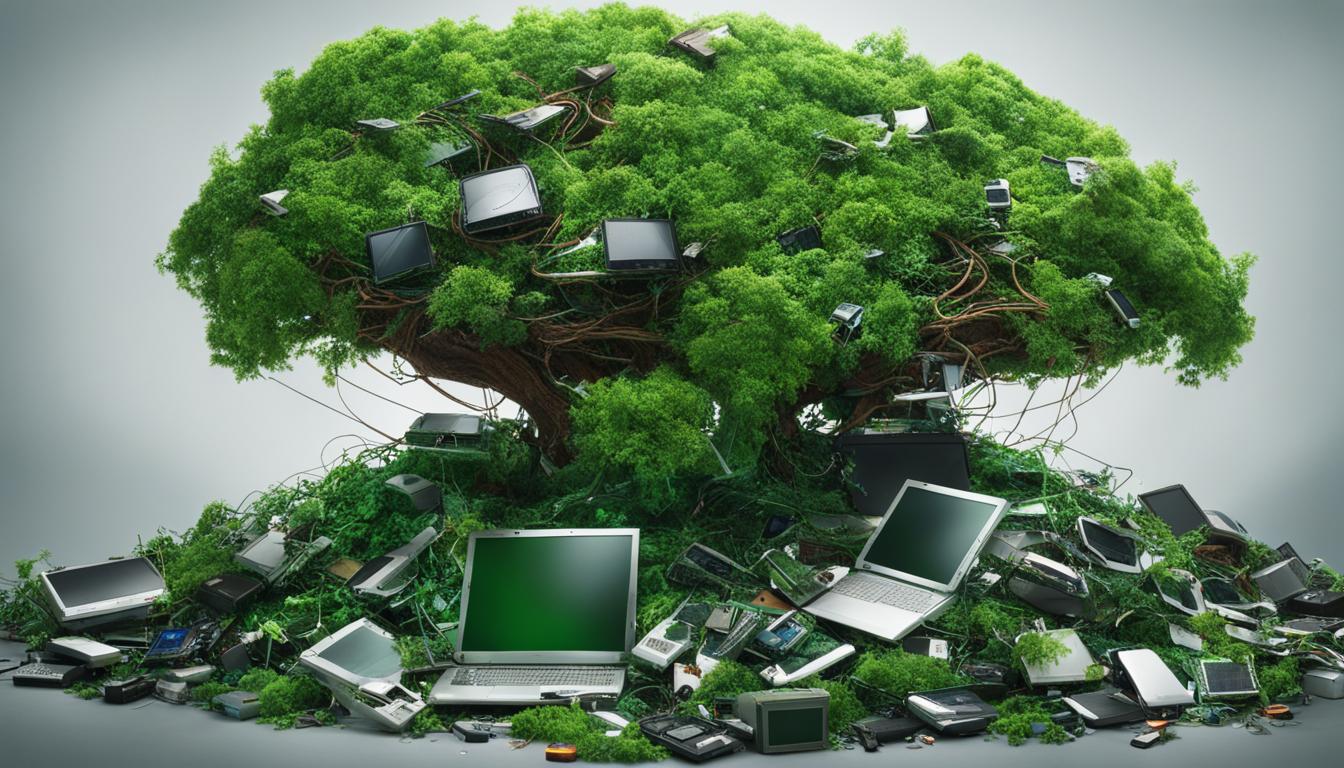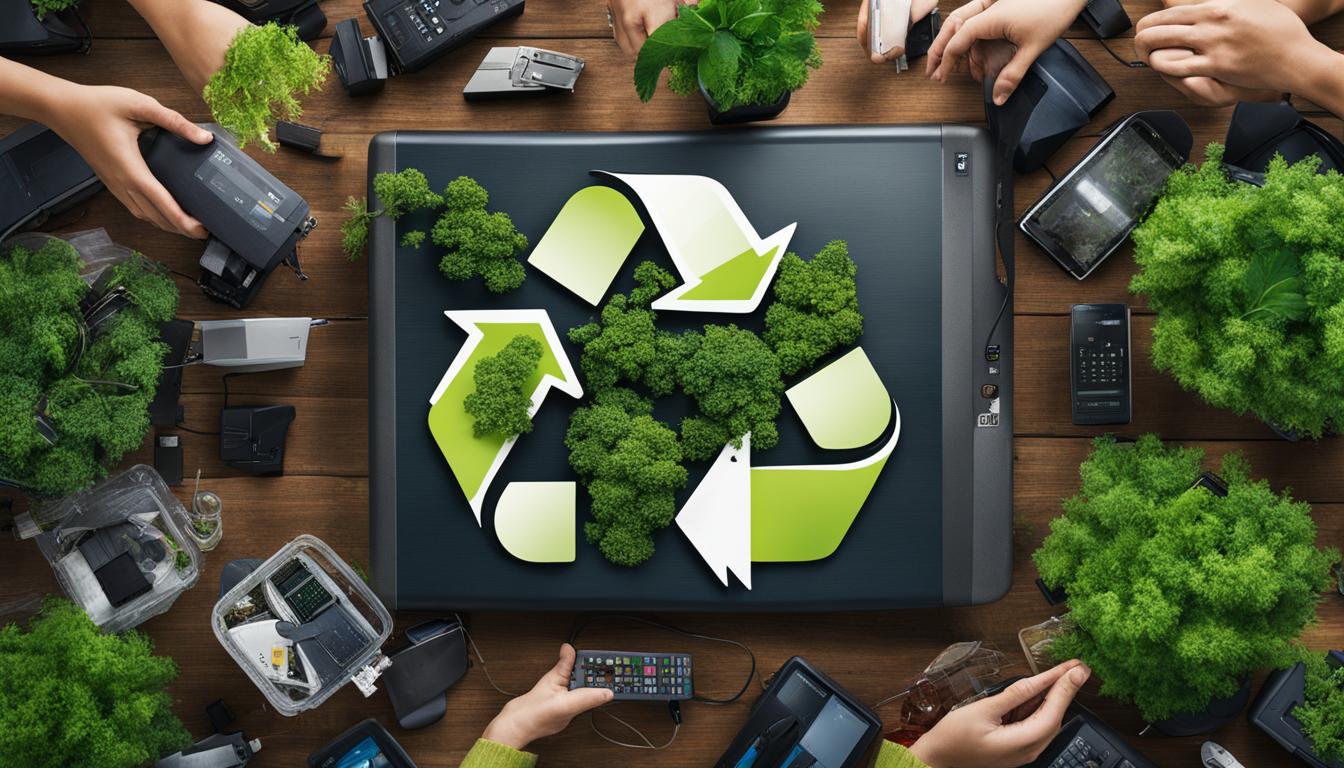Reducing Carbon Footprint Through IT Recycling
Recycling plays a crucial role in reducing carbon emissions and mitigating the effects of climate change. When new products are created, resources are extracted, and the production process generates greenhouse gas emissions, primarily carbon dioxide. These emissions contribute to global warming, melting polar ice caps, rising sea levels, and extreme weather events. However, by recycling and using recycled materials, we can reduce the energy and carbon emissions associated with the production and transportation of new goods. Even simple actions like recycling office paper can make a significant difference, reducing greenhouse gas emissions by as much as 80 metric tonnes of carbon dioxide.
Key Takeaways:
- IT recycling is essential for reducing carbon emissions and minimizing the environmental impact.
- Recycling electronic devices helps conserve resources and promotes a circular economy.
- Proper IT waste management through recycling prevents harmful substances from entering the environment.
- Businesses can significantly reduce their carbon footprint by incorporating recycling practices.
- Recycling office paper is a simple yet impactful way to contribute to a greener, more sustainable future.
The Importance of Recycling in Carbon Footprint Reduction
Recycling is a crucial component of sustainable IT practices and plays a significant role in reducing the carbon footprint associated with electronic waste. Improper disposal of electronic devices contributes to the growing problem of e-waste, which not only poses environmental risks but also leads to increased carbon emissions. By recycling electronic devices, we can recover valuable materials and minimize the need for raw material extraction and energy-intensive manufacturing processes.
Electronic waste includes components such as metals, plastics, and glass, all of which require significant energy and resources to produce. When these materials are recycled, they can be transformed into new products, reducing the demand for virgin resources and the associated carbon emissions. Recycling also helps promote a circular economy by ensuring that valuable resources are reused and diverted from the landfill. Through proper recycling practices, we can conserve resources, minimize carbon emissions, and contribute to global efforts to combat climate change.
By recycling electronic devices, we can recover valuable materials and reduce the need for raw material extraction and energy-intensive manufacturing processes.
Furthermore, recycling electronic devices helps mitigate the environmental impact of their disposal. Many electronic devices contain hazardous substances, such as lead, mercury, and cadmium, which can be harmful to both human health and the environment if not handled properly. When e-waste is sent to landfills or incinerated, these hazardous materials can leach into the soil and water, posing a risk to ecosystems and potentially contaminating food sources. By recycling electronic devices, we can ensure that these hazardous materials are safely managed and prevented from causing further harm to the environment.
In summary, recycling plays a vital role in reducing the carbon footprint associated with electronic waste. It helps conserve resources, minimize carbon emissions, and promote a circular economy by recovering valuable materials and reducing the demand for virgin resources. Through responsible recycling practices, we can contribute to a greener and more sustainable future.
The Environmental Benefits of Recycling Electronic Devices
| Environmental Benefits | Explanation |
|---|---|
| Reduces carbon emissions | Recycling electronic devices reduces the need for energy-intensive manufacturing processes, resulting in lower carbon emissions. |
| Conserves natural resources | By recycling electronic devices, we can minimize the need for raw material extraction, helping to conserve valuable resources. |
| Prevents environmental contamination | Proper disposal of electronic devices prevents hazardous substances from leaching into the environment, safeguarding ecosystems and human health. |
| Promotes a circular economy | Recycling electronic devices ensures that valuable resources are reused and diverted from landfills, contributing to a more sustainable economic model. |
Remember, recycling electronic devices is not only important for reducing the carbon footprint but also for minimizing environmental risks and promoting a more sustainable future.
The Environmental Benefits of Recycling in IT Waste Management
Recycling is an essential part of responsible IT waste management and promotes green computing practices. By recycling IT hardware, we can divert electronic waste from landfills, preventing harmful substances from leaching into the environment. Additionally, recycling reduces the need for raw materials and energy-intensive manufacturing processes, resulting in lower carbon emissions. It also helps in the conservation of natural resources and reduces the environmental impact of IT equipment disposal.
Benefits of Recycling in IT Waste Management
Recycling IT hardware offers several environmental benefits:
- Reduces landfill waste: By diverting electronic waste from landfills, recycling helps prevent hazardous materials from polluting the environment.
- Conserves resources: Recycling IT equipment allows for the recovery of valuable materials, reducing the need for raw material extraction and minimizing resource depletion.
- Reduces carbon emissions: The recycling process requires less energy compared to manufacturing new products, resulting in lower carbon dioxide emissions.
- Promotes circular economy: Recycling enables the reuse and repurposing of resources, contributing to a more sustainable economic model.

The Importance of Green Computing
In addition to traditional recycling practices, green computing is crucial for minimizing the environmental impact of IT waste. Green computing focuses on reducing energy consumption, promoting energy-efficient equipment, and adopting sustainable IT practices. By implementing energy-saving measures and proper IT waste management, businesses can further decrease their carbon footprint and contribute to a greener future.
| Green Computing Strategies | Environmental Impact |
|---|---|
| Energy-efficient hardware | Reduces energy consumption and carbon emissions |
| Virtualization and cloud computing | Optimizes resource utilization and reduces hardware disposal |
| Power management settings | Reduces energy wastage and prolongs equipment lifespan |
| Responsible e-waste disposal | Prevents hazardous materials from entering the environment |
By incorporating both recycling and green computing practices, businesses can make significant progress in reducing their carbon footprint and ensuring sustainable IT waste management.
The Role of Recycling in Sustainable Business Practices
In today’s world, businesses have a responsibility to adopt sustainable practices, including eco-friendly technology disposal. By incorporating recycling into their operations, businesses can significantly reduce their carbon footprint. Recycling materials like plastic, paper, and other waste decreases the amount of carbon dioxide and other greenhouse gases emitted by companies. It also helps in waste prevention and management by reducing packaging, reusing materials, and implementing effective recycling strategies.
Implementing sustainable IT practices can have numerous benefits for businesses. Firstly, it demonstrates a commitment to environmental responsibility, which can enhance a company’s reputation and attract eco-conscious customers. Secondly, recycling and responsibly managing IT waste can lead to cost savings. By reusing materials and reducing the need for raw material extraction, businesses can reduce their procurement costs. Additionally, effective waste management strategies can decrease waste disposal costs. By implementing comprehensive recycling programs and partnering with recycling organizations, businesses can ensure that their IT waste is properly handled and recycled.
Recycling also promotes a circular economy, where materials are reused and repurposed instead of being discarded. By participating in the recycling process, businesses contribute to the creation of a sustainable and self-sufficient economy. They can close the loop by using recycled materials in their production processes, reducing the demand for new resources and minimizing their environmental impact.
In summary, incorporating recycling into sustainable business practices is essential for reducing the carbon footprint and promoting a greener future. By responsibly managing IT waste and implementing effective recycling strategies, businesses can demonstrate their commitment to environmental stewardship, reduce costs, and contribute to the circular economy. Embracing sustainable IT practices and eco-friendly technology disposal is not only beneficial for businesses but also for the planet we all share.
The Environmental Impact of Recycling Office Paper
When it comes to reducing environmental impact and promoting IT sustainability, one area that often gets overlooked is office paper recycling. While it may seem like a small step, recycling office paper can have a significant positive effect on reducing carbon footprint and conserving resources.
By recycling office paper, businesses can save energy, water, and trees. The production of paper from virgin materials requires a considerable amount of energy and water, while recycling paper uses less energy and water, resulting in lower carbon dioxide and greenhouse gas emissions. In fact, recycling one tonne of paper can save around 17 trees, 7,000 gallons of water, and 3 cubic yards of landfill space. It’s a simple yet impactful way for businesses to contribute to a greener, more sustainable future.
Implementing an office paper recycling program is relatively easy. Companies can set up designated recycling bins throughout the office and educate employees on the importance of recycling paper. Additionally, they can partner with recycling companies that specialize in paper recycling to ensure that the paper is properly processed and reused in the production of new paper products, closing the loop in the recycling process.

Not only does recycling office paper help reduce carbon emissions, but it also has economic benefits. Recycling paper reduces waste disposal costs for businesses, as landfill fees and waste management expenses can be significant. By recycling paper, companies can save money while also promoting sustainable and responsible IT practices.
In summary, office paper recycling is an effective way for businesses to reduce their carbon footprint and make a positive impact on the environment. By implementing an office paper recycling program, companies can conserve resources, reduce greenhouse gas emissions, and contribute to a more sustainable future for all.
Conclusion
Recycling plays a crucial role in reducing the carbon footprint associated with IT waste and effectively contributes to environmental preservation. By engaging in IT recycling, businesses can actively reduce greenhouse gas emissions, conserve valuable resources, and promote the adoption of circular economy principles.
Implementing sustainable IT practices and actively participating in recycling initiatives are key to mitigating the harmful effects of global warming and the climate crisis. By recycling materials instead of discarding them, businesses can significantly decrease carbon emissions and contribute to a greener, more sustainable future.
Furthermore, alongside recycling, waste prevention and effective waste management strategies are essential in further reducing carbon footprint. Adopting these practices will lead to a significant positive impact on the environment and help in creating a more eco-friendly business landscape.
It is vital for businesses to realize their responsibility and actively embrace IT recycling and other sustainable practices in order to reduce their carbon footprint. So, why wait? Start recycling today and make a positive impact on the environment!
FAQ
Why is recycling important for reducing carbon footprint?
Recycling plays a crucial role in reducing carbon emissions by reducing the energy and carbon emissions associated with the production and transportation of new goods.
How does recycling electronic devices help reduce carbon emissions?
Recycling electronic devices helps conserve resources, minimize carbon emissions, and promote a circular economy by reducing the need for raw material extraction and energy-intensive manufacturing processes.
How does recycling IT hardware promote green computing practices?
Recycling IT hardware helps divert electronic waste from landfills, preventing harmful substances from leaching into the environment. It also reduces the need for raw materials and energy-intensive manufacturing processes, resulting in lower carbon emissions.
Why should businesses adopt recycling practices for IT waste?
By incorporating recycling into their operations, businesses can significantly reduce their carbon footprint, decrease the amount of greenhouse gases emitted, and promote waste prevention and management.
How does recycling office paper contribute to reducing the carbon footprint?
Recycling office paper saves energy, water, and trees, leading to a decrease in carbon dioxide and other greenhouse gas emissions. It also helps reduce waste disposal costs and promotes sustainable and responsible IT practices.
What are the environmental benefits of recycling materials?
Recycling materials helps reduce greenhouse gas emissions, conserve resources, and promote a circular economy. It also plays a crucial role in mitigating the effects of global warming and the climate crisis.













